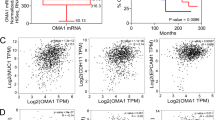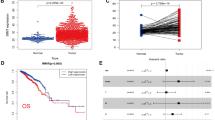Abstract
Mitochondria combine hydrogen and oxygen to produce heat and adenosine triphosphate (ATP). As a toxic by-product of oxidative phosphorylation (OXPHOS), mitochondria generate reactive oxygen species (ROS). These free radicals may cause damage to mitochondrial DNA (mtDNA) and other molecules in the cell. Nitric oxide (NO) plays an important role in the biology of human cancers, including breast cancer; however, it is still unclear how NO might affect the mitochondrial genome. The aim of the current study is to determine the role of mtDNA in the breast oncogenic process. Using DNA sequencing, we studied one breast cancer cell line as a model system to investigate the effects of oxidative stress. The BT-20 cell line was fully adapted to increasing concentrations of the NO donor DETA-NONOate and is referred to as BT-20-HNO, a high NO (HNO) cell line. The HNO cell line is biologically different from the “parent” cell line from which it originated. Moreover, we investigated 71 breast cancer biopsies and the corresponding noncancerous breast tissues. The free radical NO was able to generate somatic mtDNA mutations in the BT-20-HNO cell line that were missing in the BT-20 parent cell line. We identified two somatic mutations, A4767G and G13481A, which changed the amino acid residues. Another two point mutations were identified in the mtDNA initiation replication site at nucleotide 57 and at the ‘hot spot’ cytidine-rich D300–310 segment. Furthermore, the NO regulated the mtDNA copy number and selected different mtDNA populations by clonal expansion. Interestingly, we identified eight somatic mutations in the coding regions of mtDNAs of eight breast cancer patients (8/71, 11.2 %). All of these somatic mutations changed amino acid residues in the highly conserved regions of mtDNA which potentially leads to mitochondrial dysfunctions. The other two somatic mtDNA mutations in the displacement loop (D-loop) region [303:315 C(7–8)TC(6) and nucleotide 57] were distributed among 14 patients (14/71, 19.7 %). Importantly, of these 14 patients, six had mutations in the p53 gene. These results validate the BT-20 parent/HNO cell line model system as a means to study ROS damage in mtDNA, as it parallels the results found in a subset of the patient population.






Similar content being viewed by others
References
Hancock JT. The role of redox mechanisms in cell signalling. Mol Biotechnol. 2009;43(2):162–6.
Wallace DC. Mitochondria as chi. Genetics. 2008;179(2):727–35.
Clay Montier LL, Deng JJ, Bai Y. Number matters: control of mammalian mitochondrial DNA copy number. J Genet Genomics. 2009;36(3):125–31.
Larsson NG. Somatic mitochondrial DNA mutations in mammalian aging. Annu Rev Biochem. 2010;79:683–706.
Wallace DC. A mitochondrial paradigm of metabolic and degenerative diseases, aging, and cancer: a dawn for evolutionary medicine. Annu Rev Genet. 2005;39:359–407.
Chatterjee A, Mambo E, Sidransky D. Mitochondrial DNA mutations in human cancer. Oncogene. 2006;25(34):4663–74.
Lee HC, Wei YH. Mitochondrial DNA instability and metabolic shift in human cancers. Int J Mol Sci. 2009;10(2):674–701.
Lu J, Sharma LK, Bai Y. Implications of mitochondrial DNA mutations and mitochondrial dysfunction in tumorigenesis. Cell Res. 2009;19(7):802–15.
Thomsen LL, et al. Nitric oxide synthase activity in human breast cancer. Br J Cancer. 1995;72(1):41–4.
Bentz BG, et al. Nitric oxide synthase type 3 is increased in squamous hyperplasia, dysplasia, and squamous cell carcinoma of the head and neck. Ann Otol Rhinol Laryngol. 1999;108(8):781–7.
Ambs S, et al. Frequent nitric oxide synthase-2 expression in human colon adenomas: implication for tumor angiogenesis and colon cancer progression. Cancer Res. 1998;58(2):334–41.
Bentz BG, et al. Endothelial constitutive nitric oxide synthase (ecNOS) localization in normal and neoplastic salivary tissue. Head Neck. 1998;20(4):304–9.
Wink DA, et al. The multifaceted roles of nitric oxide in cancer. Carcinogenesis. 1998;19(5):711–21.
Glynn SA, et al. Increased NOS2 predicts poor survival in estrogen receptor-negative breast cancer patients. J Clin Invest. 2010;120(11):3843–54.
Bentz BG, Haines 3rd GK, Radosevich JA. Increased protein nitrosylation in head and neck squamous cell carcinogenesis. Head Neck. 2000;22(1):64–70.
Thomas DD, et al. The chemical biology of nitric oxide: implications in cellular signaling. Free Radic Biol Med. 2008;45(1):18–31.
Jenkins DC, et al. Roles of nitric oxide in tumor growth. Proc Natl Acad Sci U S A. 1995;92(10):4392–6.
Koufman JA, Burke AJ. The etiology and pathogenesis of laryngeal carcinoma. Otolaryngol Clin North Am. 1997;30(1):1–19.
Moller P, et al. Air pollution, oxidative damage to DNA, and carcinogenesis. Cancer Lett. 2008;266(1):84–97.
Brandon M, Baldi P, Wallace DC. Mitochondrial mutations in cancer. Oncogene. 2006;25(34):4647–62.
Wallace DC. Why do we still have a maternally inherited mitochondrial DNA? Insights from evolutionary medicine. Annu Rev Biochem. 2007;76:781–821.
Ralph SJ, et al. The causes of cancer revisited: “mitochondrial malignancy” and ROS-induced oncogenic transformation—why mitochondria are targets for cancer therapy. Mol Aspects Med. 2010;31(2):145–70.
Chandra D, Singh KK. Genetic insights into OXPHOS defect and its role in cancer. Biochim Biophys Acta. 2011;1807(6):620–5.
Todorov IN, Todorov GI. Multifactorial nature of high frequency of mitochondrial DNA mutations in somatic mammalian cells. Biochemistry (Mosc). 2009;74(9):962–70.
Attardi G, Schatz G. Biogenesis of mitochondria. Annu Rev Cell Biol. 1988;4:289–333.
Liu P, Demple B. DNA repair in mammalian mitochondria: much more than we thought? Environ Mol Mutagen. 2010;51(5):417–26.
Vesper BJ, et al. Long-term adaptation of breast tumor cell lines to high concentrations of nitric oxide. Tumor Biol. 2010;31(4):267–75.
Lasfargues EY, Ozzello L. Cultivation of human breast carcinomas. J Natl Cancer Inst. 1958;21(6):1131–47.
Blin N, Stafford DW. A general method for isolation of high molecular weight DNA from eukaryotes. Nucleic Acids Res. 1976;3(9):2303–8.
Anderson S, et al. Sequence and organization of the human mitochondrial genome. Nature. 1981;290(5806):457–65.
Mambo E, et al. Tumor-specific changes in mtDNA content in human cancer. Int J Cancer. 2005;116(6):920–4.
Fish J, Raule N, Attardi G. Discovery of a major D-loop replication origin reveals two modes of human mtDNA synthesis. Science. 2004;306(5704):2098–101.
Tan DJ, Bai RK, Wong LJ. Comprehensive scanning of somatic mitochondrial DNA mutations in breast cancer. Cancer Res. 2002;62(4):972–6.
Gasparre G, et al. Disruptive mitochondrial DNA mutations in complex I subunits are markers of oncocytic phenotype in thyroid tumors. Proc Natl Acad Sci U S A. 2007;104(21):9001–6.
Hung WY, et al. Somatic mutations in mitochondrial genome and their potential roles in the progression of human gastric cancer. Biochim Biophys Acta. 2010;1800(3):264–70.
Gochhait S, et al. Concomitant presence of mutations in mitochondrial genome and p53 in cancer development—a study in north Indian sporadic breast and esophageal cancer patients. Int J Cancer. 2008;123(11):2580–6.
Salas A, et al. A critical reassessment of the role of mitochondria in tumorigenesis. PLoS Med. 2005;2(11):e296.
Czarnecka AM, et al. Molecular oncology focus—is carcinogenesis a ‘mitochondriopathy’? J Biomed Sci. 2010;17:31.
Bayona-Bafaluy MP, et al. Maternally inherited susceptibility to cancer. Biochim Biophys Acta. 2011;1807(6):643–9.
Warburg O. On respiratory impairment in cancer cells. Science. 1956;124(3215):269–70.
Vesper BJ, Onul A, Haines III GK, et al. Part I. Molecular and cellular characteristics of high nitric oxide-adapted human breast adenocarcinoma cell lines. Tumor Biol. 2012. doi:10.1007/s13277-012-0530-0.
De Vitto H, Mendonça BS, Elseth KM, et al. Part III. Molecular changes induced by high nitric oxide adaptation in human breast cancer cell line BT-20 (BT-20-HNO): a switch from aerobic to anaerobic metabolism. Tumor Biol. 2012. doi:10.1007/s13277-012-0564-3.
Yu M, et al. Reduced mitochondrial DNA copy number is correlated with tumor progression and prognosis in Chinese breast cancer patients. IUBMB Life. 2007;59(7):450–7.
Laderman KA, et al. Aging-dependent functional alterations of mitochondrial DNA (mtDNA) from human fibroblasts transferred into mtDNA-less cells. J Biol Chem. 1996;271(27):15891–7.
Heyne K, et al. Identification of a putative p53 binding sequence within the human mitochondrial genome. FEBS Lett. 2004;578(1–2):198–202.
Achanta G, et al. Novel role of p53 in maintaining mitochondrial genetic stability through interaction with DNA Pol gamma. EMBO J. 2005;24(19):3482–92.
Zhou S, et al. Frequency and phenotypic implications of mitochondrial DNA mutations in human squamous cell cancers of the head and neck. Proc Natl Acad Sci U S A. 2007;104(18):7540–5.
Author information
Authors and Affiliations
Corresponding author
Rights and permissions
About this article
Cite this article
De Vitto, H., Mendonça, B.S., Elseth, K.M. et al. Part II. Mitochondrial mutational status of high nitric oxide adapted cell line BT-20 (BT-20-HNO) as it relates to human primary breast tumors. Tumor Biol. 34, 337–347 (2013). https://doi.org/10.1007/s13277-012-0555-4
Received:
Accepted:
Published:
Issue Date:
DOI: https://doi.org/10.1007/s13277-012-0555-4




